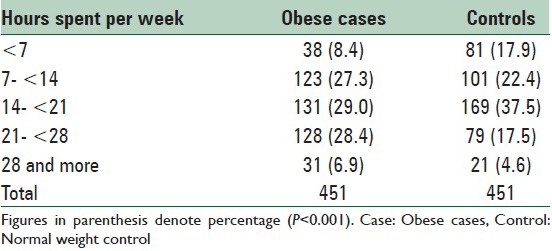DEAR EDITOR,
Duration of time spent on television (TV) viewing, computer and video games have been linked to childhood obesity. A causal relationship with lifestyle disorders has been documented.[1] The lack of physical activity has been considered as one of the important predisposing factor for obesity. The concurrent with a decrease in energy expenditure increased time for leisure activities has been associated with the epidemic of obesity.[2]
Limited data are available on duration of time spent on these leisure time sedentary activities amongst obese and nonobese children.
Hence, we conducted a school based study on assessment of the duration of time spent on sedentary leisure time activities among obese and nonobese children in National Capital Territory of Delhi. A total of 16,595 children in the age group 6–18 years were surveyed to assess the prevalence of obesity. The findings of this large survey have been published earlier.[3] Obese children were identified by utilizing body mass index based International Obesity Task Force classification.[4] A total of 493 obese children were identified in the study. Four hundred fifty one children, who consented to participate in the sub study were included.
Duration of time spent on TV, computer and video games were compared between obese children (451 cases) and nonobese children (451 controls). The groups were matched for their age (±2 years), sex and socio-economic status. The children were enquired about time spent by him/her on such leisure activities during last 7 days. A predesigned and pretested questionnaire was utilized for assessment of the leisure activities. It was found that time spent on TV, computer and video games were significantly higher among the obese children when compared with nonobese (P < 0.001) [Table 1]. The odds of getting obese were found to be 2.96 (2.20–3.99) times higher among children, who spent >28 h on these activities. Several studies from India have documented that reduced physical activity plays a major role in causing childhood obesity. According to recent study children, who viewed TV for more than 1.5 h/day have 19.6 times higher risk of being overweight (P = 0.001).[5]
Table 1.
Distribution of obese cases and matched controls according to number of hours spent in television viewing, computer and video games during last 7 days

It is recommended by American Academy of Pediatrics, that the children's total time spent on TV, computer and video games to be limited to no more than 1–2 h of quality programming per day, that is, 7–14 h/week.[6]
In our study, we found that 64.3% cases and 59.6% control group children spent more than 14 h/week on TV viewing [Table 1].
The findings of the present study are more critical for the developed countries as compared to developing nations. The evidence forms developed countries have shown that TV viewing and lack of physical activity are two major factors contributors to childhood obesity.[2] There are many associated factors, which could be linked to obesity, and duration of time spent on TV, computer and video games like increased snacking behavior, motivation to consume junk food by advertisements and interference with normal sleep patterns.[1]
To combat current epidemic of obesity among children, we will require a major change in society's recognition to the adverse impact of duration of time spent on TV, computer and video games. This is a major risk factor for obesity.[7]
REFERENCES
- 1.Robinson TN. Reducing children's television viewing to prevent obesity: A randomized controlled trial. JAMA. 1999;282:1561–7. doi: 10.1001/jama.282.16.1561. [DOI] [PubMed] [Google Scholar]
- 2.Burke V, Beilin LJ, Simmer K, Oddy WH, Blake KV, Doherty D, et al. Predictors of body mass index and associations with cardiovascular risk factors in Australian children: A prospective cohort study. Int J Obes (Lond) 2005;29:15–23. doi: 10.1038/sj.ijo.0802750. [DOI] [PubMed] [Google Scholar]
- 3.Kaur S, Sachdev HP, Dwivedi SN, Lakshmy R, Kapil U. Prevalence of overweight and obesity amongst school children in Delhi, India. Asia Pac J Clin Nutr. 2008;17:592–6. [PubMed] [Google Scholar]
- 4.Cole TJ, Bellizzi MC, Flegal KM, Dietz WH. Establishing a standard definition for child overweight and obesity worldwide: International survey. BMJ. 2000;320:1240–3. doi: 10.1136/bmj.320.7244.1240. [DOI] [PMC free article] [PubMed] [Google Scholar]
- 5.Kuriyan R, Bhat S, Thomas T, Vaz M, Kurpad AV. Television viewing and sleep are associated with overweight among urban and semi-urban South Indian children. Nutr J. 2007;6:25. doi: 10.1186/1475-2891-6-25. [DOI] [PMC free article] [PubMed] [Google Scholar]
- 6.American Academy of Pediatrics. Committee on public education American academy of pediatrics: Children, adolescents, and television. Pediatrics. 2001;107:423–6. doi: 10.1542/peds.107.2.423. [DOI] [PubMed] [Google Scholar]
- 7.Brownell KD, Schwartz MB, Puhl RM, Henderson KE, Harris JL. The need for bold action to prevent adolescent obesity. J Adolesc Health. 2009;45(45):S8–17. doi: 10.1016/j.jadohealth.2009.03.004. [DOI] [PubMed] [Google Scholar]


